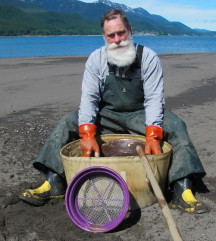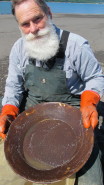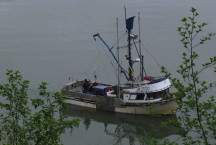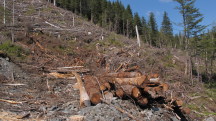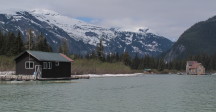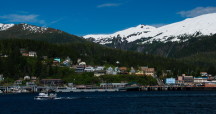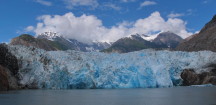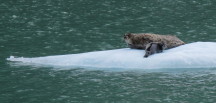While painting with several Plein Rein Painters along Sandy Beach in Juneau, I noticed a man at the edge of the water digging in the sand. “He’s probably prospecting for gold,” said Jim Heumann. “This is the site of the old mine pier.” The incoming tide would soon chase him away, so I stashed my brush and headed across the mud flats to chat.
I soon learned that Dave and his dog, Buddy, live on his boat. A retired fisherman, he prospects to supplement the Social Security income which he says is, “Waaay too small to live on here in Alaska”. He puts shovel after shovel of sand into a collapsible plastic tub and adds water to help “sort out the good stuff.”
According to Jim, if he continues to work there during the low tides, there is a good chance the mining company will chase him off—or even confiscate the gold he finds. Dave showed me some of his “gold dust” in the bottom of the pan, but the mining company owns all mining rights to the land even though the buildings are torn down and the pier is long gone.
Everywhere we’ve traveled on the Inside Passage, I’ve chatted with people, like Dave, who came to Alaska for a visit, were captivated by the beauty, and wound up staying for a lifetime. We’ve met many people who embrace the danger and hard work that come with fishing, lumbering or mining jobs. It seems all too common for Alaskans to endure high expenses for food, transportation and services while living for years in houses without electricity or indoor plumbing.
Most families living on these islands own at least two boats and maybe one car. “With a car, you can only go up and down 30 miles of road”, said one new friend, “but with a boat you can go anywhere!”
The Alaska Marine Highway carries the lifeblood for the 35 communities in the Inside Passage, all of which are within the Tongass National Forrest. When our ferry stopped at Angoon, a Tlingit community with a population of 459, watching people receive their packages was a little like watching a family open gifts on Christmas morning. Cars and trucks left the dock overflowing with boxes of food and goods. One even had the sunroof open with someone inside reaching out to hold onto a little girl’s bike that had just arrived. Sometimes I found the shelves fairly empty in the community grocery store the day before the weekly ferry arrival.
Without a doubt, this part of the country is spectacular. I am writing this post in our RV next to the small boat harbor in Haines, gazing at beautiful mountain vistas along the sea in every direction, and recalling numerous magnificent views from Ketchikan, Wrangell, Petersburg, Sitka, and Juneau.
But I am also aware of the significant hardships that many of the rugged folks who choose to live here embrace in order to dwell among the glaciers, whales, moose, bears and other critters that delight us all—visitors and locals alike, and even getting in touch with the effect it has had on me.
Painting in the Tongass National Forest has been an astounding experience for for which I am truly grateful. Although six weeks here may seem like a decadent luxury, the time has flown by so fast I’ve barely touched the surface of what these lands and seas have to offer. Nonetheless, today I find that I am much more attuned to my surroundings—not just because I’m a visitor amidst wonderful new sights, but because there’s a potential danger in not paying attention out here. I listen more closely for animals, usually talking and singing when I’m on my own, and keep a close eye on changing tides and weather patterns. Even in this short time, Alaska—the land and the people—have had their impact on me. I truly have found it to be a changing frontier.
